Trusted by:
Updated: June 24, 2025
21 min read
How to Build Better Donor Relations: The Ultimate Guide
Donor relations aren't just about pure fundraising play. They're about building deep, meaningful connections. Set aside the money-first mindset – focus on personalized communication, trust, and showing real impact. Today, we'll show you how the right strategies and tools can bring long-term support to your nonprofit while making every donor feel valued and appreciated.
Imagine your nonprofit organization as a spring garden. Each donor is a seed with the potential to grow into a strong, supportive plant.
Building strong donor relationships is like tending this garden. Without proper care, these seeds won't flourish. And with proper care, their contributions could blossom beyond your expectations. Who knows how far their support will spread?
This is why donor relations must be an irreplaceable part of your fundraising strategy. Yet, this is the part that is often neglected and overlooked in vain.
So, the question is, how do you build long-lasting relationships with donors?
Today, we’ll discuss donor relations in detail — how to build, maintain, and scale them with the right approach. There are many ways to do so! Starting from the tips on how to hold each donor in high regard with personalized donation certificate templates, and ending with practical examples you can adapt for your own strategy.
🏆 By the end of this article, you will have actionable strategies for building donor relationships and increasing donor retention – for years (and donations) to come.
Let’s nurture your garden of donors, shall we?
What are donor relations?
Donor relations refer to the management of relationships between a nonprofit and its donors.
Donor relations aren’t like normal relationships. They start from a transactional point but evolve into meaningful connections. Donors don’t get involved in your fundraising to make money – they do that to make an impact. Solid donor relationships build trust and encourage ongoing support.
What is donor stewardship?
Donor stewardship is the process of managing and nurturing donor relationships to build loyalty and trust. For example, through expressing gratitude with personalized messages. (We've recently launched a new collection of donor stewardship templates to help you craft such impactful messages to thank donors.)
But donor stewardship isn’t just about saying thank you. It’s a strategic approach to deepen donor commitment. Effective stewardship allows donors to feel valued and see the impact of their contributions, which, in turn – brings fundraisers closer to receiving long-term support.
Difference between donor relations and donor stewardship
For many, the terms are interchangeable, but this could not be further from the truth.
Donor relations focus on building and managing the overall relationship with donors. It includes all interactions and communications aimed at engaging donors, including those done before they become donors.
Donor stewardship centers on the ongoing care and nurturing of donors after their initial gift. It ensures donors feel appreciated and see the impact of their contributions.
🙌🏻 How do they complement each other? Donor relations initiate and develop the connection. Donor stewardship maintains and strengthens that bond over time. Together, they create a holistic approach to donor management.
The main goal of both is to build a connection so strong that it would secure long-term support. However, specific goals per campaign or fundraiser can vary based on your nonprofit’s mission and the unique needs of your donor base.
The rest of the article will reveal more tailored strategies and considerations.
Why donor relations are SO important?
Donor relations strategy doesn’t just cover sending a simple “thank you” – when done properly, it can keep bringing the results around the clock. Check why you should invest your time and resources in donor communication if you haven’t done that yet.
Improve donor retention
Strong donor relations increase loyalty. Donors who see and feel the impact of their contributions are more likely to continue supporting your nonprofit or to recommend others to do so as well. Solid donor relationships lead to higher donor retention rates and sustained financial support.
Hold better events
Effective donor relations can result in more engaged supporters. Engaged donors attend and participate in fundraising events rather than skipping them. With the right strategy, nonprofits can capitalize on the natural connection between online and offline donor cultivation through events.
Increase recurring donations
Maintain regular communication and show appreciation, as this prompts donors to set up ongoing contributions. A steady revenue stream will allow your organization to run sustainably and serve its purpose.
Acquire new donors
Satisfied donors become your best advocates. They recommend your nonprofit to others, bring in new donors, and promote nonprofit organizations on their own. Word-of-mouth referrals from a well-maintained donor database can attract supporters pre-disposed to help your cause.
Build a strong network
If you care about donor interaction, you can build a network of committed supporters quicker than other organizations. Such a network offers more than donor gifts; it also offers additional resources, connections, and opportunities for your nonprofit. A solid network amplifies both your impact and reach in the long run.
All these benefits might not seem like instant wins, but when connected with donor motivations, they become clear.
Understanding what drives each particular donor helps translate these benefits into actionable strategies. Next, we'll explore donor motivations and how to use them for relationship building.
What’s behind donor motivations?
We already established that donors do not support nonprofits for monetary gain. Unlike many companies driven by profit, donors are motivated by deeper, more personal reasons.
They are driven by Philanthropic values, Impact, Emotional connections, and Setting personal goals (PIES©).
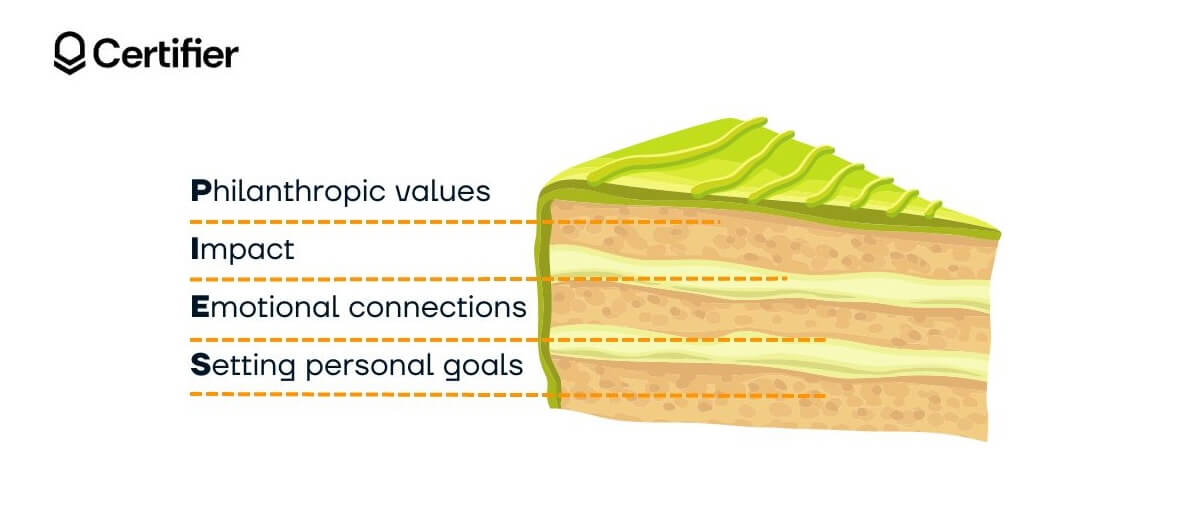 P for Philanthropic values
P for Philanthropic values
Personal stories resonate really deeply with donors. When a nonprofit shares narratives that reflect the donors' own experiences or those of their loved ones, it creates a strong personal connection. This connection makes donors feel like they are part of the cause – not just its supporters.
Every single donor has specific values and causes they care about, such as education, healthcare, or environmental conservation. If you align your nonprofit’s mission with these values, you can quickly make donors feel that their contributions are making a meaningful difference to what matters to them the most.
Without such an alignment, it would be incredibly difficult to secure long-term support and donor retention.
I for Impact
Donors want to make an impact. They are driven by the desire to see tangible change. They know that their financial contributions can drive real, measurable impact in the areas they care about. And they know they can help simply because they have that money at hand.
Tangible outcomes of donations are necessary to prove the impact. Anything you do to clearly show how donations are used – from success stories through donor data to outcomes – highlights the positive effects of donor contributions.
For example, if a donation funded a new school, send out updates and photos showing the newly-enrolled students. the school in use. Such transparency and evidence of impact reinforce the donor’s decision to support your cause and encourage ongoing contributions to your organization.
E for Emotional connection
It’s not about the money, it’s about the stories. Emotional stories are powerful motivators. They help donors connect deeply with your cause. It’s these stories, rather than the monetary aspect, that move donors to give and keep giving.
Imagine a C-level meeting where one director spots a certificate of appreciation on another director’s wall. This certificate, awarded for supporting a nonprofit that helps students, can actually spark a new connection. How is that? The first director, having just sent his daughter to college, now relates on a very personal level, and this connection may help seal the actual business deal.
S for Setting Personal Goals
Donors often have personal goals or aspirations – like leaving a legacy, honoring a loved one, or achieving personal growth. Understanding these aspirations and subtly addressing them in your engagement strategies can strengthen donor relationships.
As a fundraiser, you might not see these goals, but you need to cater to them unconsciously. Donors prioritize multiple goals and purposes. Your donor relationship management must be strong, especially for securing big and regular donations. Even if your initiatives are less compelling than others, the right relationship strategy can win donors’ loyalty.
If they believe in the purpose and are offered transparent communication, they can be transparent about their loyalty, too. Donors support many initiatives. To stand out, offer excellent donor relationship management. Transparent communication about the impact of their donations is what they value the most.
The art of donor relationship management involves various factors, which we will cover next. It all sounds simple, maybe even obvious – but if it really was like that, you wouldn't be reading this, and we wouldn’t be writing this one!
Now, let's move on to the challenges fundraisers face and the mistakes that can arise if these challenges are not addressed.
Common challenges that fundraisers stumble upon
Challenges in donor relationship management can be easy to address if caught early. Neglecting these issues can lead to setbacks for your nonprofit, missed donations, and weakened donor support.
Use the list below as a checklist to avoid the same mistakes.
Inability to anticipate the needs and preferences of donors
Fundraisers often struggle to foresee donor needs. Lack of information can lead to donors feeling overlooked or undervalued.
Donor preferences can vary widely, and failing to adapt can be detrimental. Whether it’s their preferred communication method or the type of recognition they appreciate, not catering to these preferences can quickly result in donor dissatisfaction.
When donor needs are not met, they may disengage, decrease donations, or even turn to a different organization. This is not ideal! To avoid any of those, use feedback loops to identify both needs and bottlenecks.
No retention strategy
High donor attrition rates can often be attributed to insufficient engagement or recognition. If donors don't feel appreciated or see the impact of their contributions, they may simply stop giving. Stewardship programs that include regular updates and personalized communication can improve retention.
Insufficient personalization
Generic communications can alienate donors who expect you to personalize any communication sent their way. When messages lack personalization, donors may feel like just another number rather than a valued part of the mission. Personalizing messages with donor names, donation histories, and specific impact stories can help you build a stronger connection and engage donors at all times.
For example, if you want to thank donors with donor certificates, you should tailor and personalize the emails that contain the credentials as well. If you decide to create certificates with Certifier, it's easy to create email templates with dynamic content that is personalized for each recipient. You can also add your own branding, change colors and fonts. Raad more on how to write email for sending certificate.
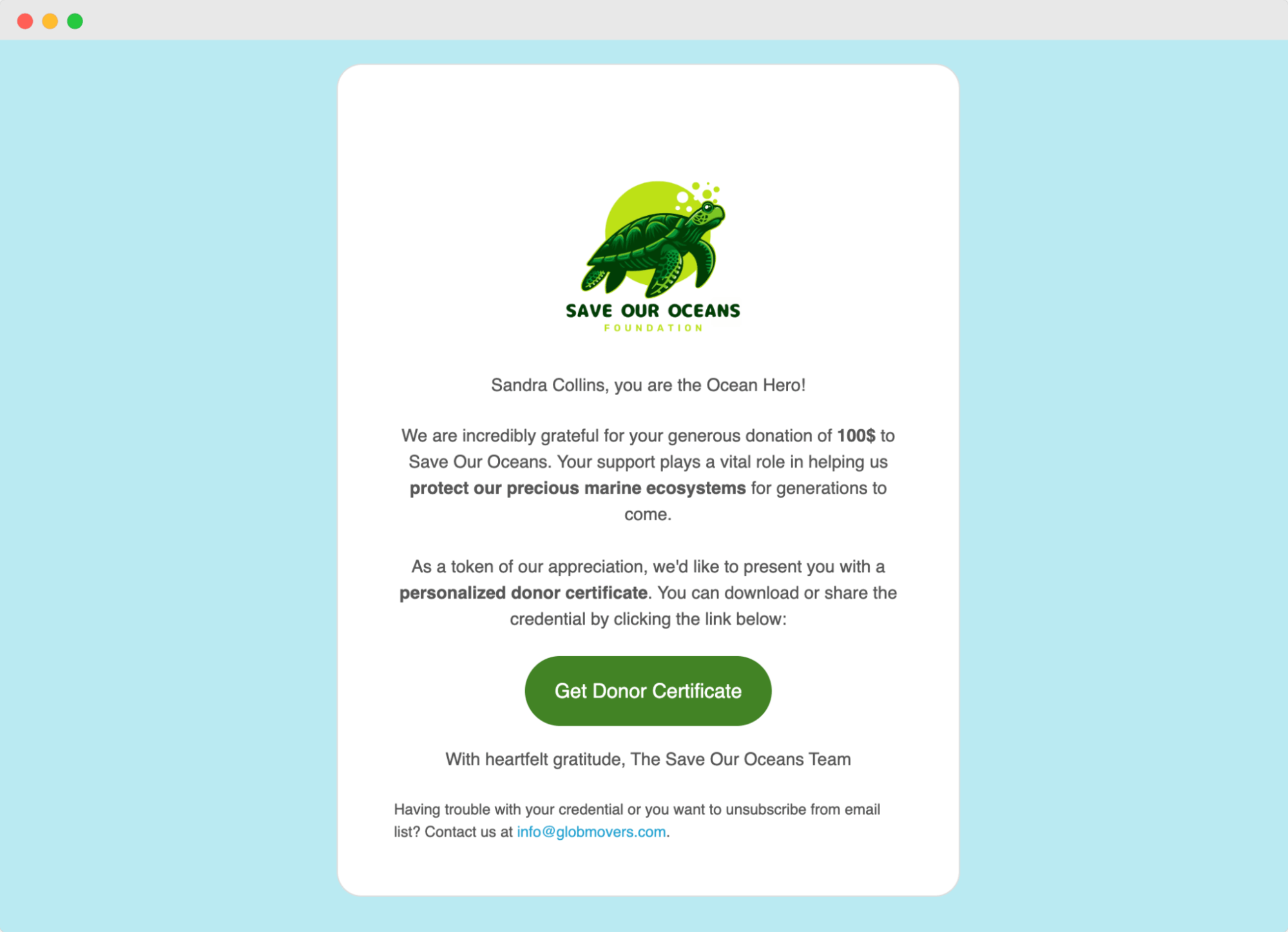
💸 Did you know that Certifier provides a 15% discount for non-profit organizations to make the certification process even easier? Contact our team to get to know more.
Lack of timeliness and consistency
Delayed acknowledgments and updates can erode donor trust. If donors don’t receive timely thank-you notes or updates on their contributions’ impact, they may feel their support is not appreciated. Inconsistent communication can confuse and frustrate donors. Without a consistent strategy, donors might miss important updates or feel disconnected from the nonprofit. Implementing automated systems for prompt responses and regular updates can mitigate this issue.
Poor data management
Ineffective management of donor data can lead to many missed opportunities and errors. Without accurate and updated donor information, personalizing communications and tracking donor preferences becomes challenging or even impossible. Donor management systems can assist you in handling donor data to ultimately improve overall donor engagement.
The other benefit of well-structured data management goes even further. In one place, you have all the honors data. You can upload these data to the certificate maker. The tool then automatically generates certificates tailored to each recipient. It’s a super simple and efficient process. Read more on how to make multiple certificates with different names.
🧰 Want to turn your donor management into a seamless experience? Integrations and custom API unlock a powerful hub that simplifies tasks and saves you valuable time.
For example, you can set up an automated system with Certifier to issue and send certificates of appreciation immediately after a donation is made. Each template is print-ready in PDF format, so donors can easily print and frame their certificates if they wish (many of them do!) to show them offline.
Overlooking small donors
Focusing solely on major donors can alienate smaller contributors. While you can think that it works more on a Pareto principle (20% donors drive 80% donations), the truth is that every donor, regardless of the donation size, deserves recognition and appreciation. Don't miss out on small donors for growth and support.
Stages of donor relationships
To run effective donor management, you should first recognize – and then, implement – donor relationship-building stages.
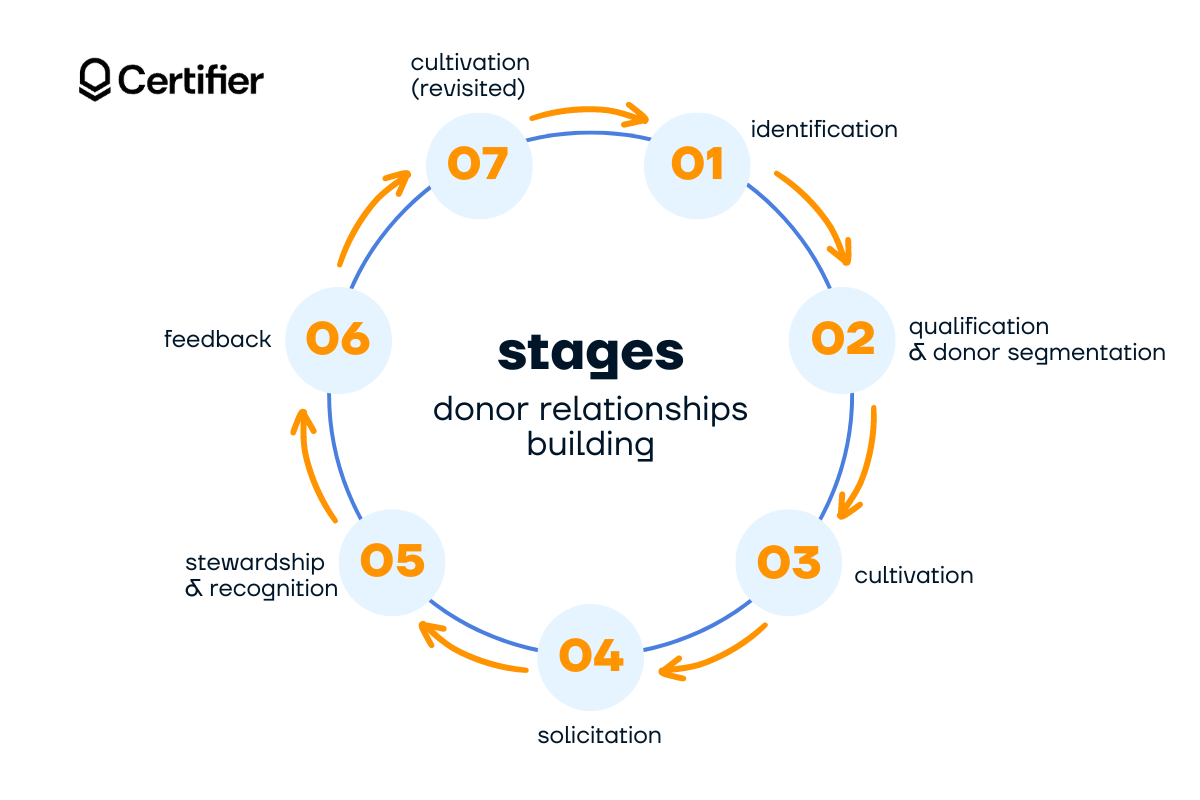
Depending on your current awareness and practices, you might have already navigated some stages – or may need to revisit them.
Stage 1: Identification
Identification involves finding potential donors who can support your nonprofit’s mission and values. You can use tools like a donor management platform to gather data on individuals or organizations showing interest in your cause. At the very beginning, even a single CRM will do!
Identifying the right donors sets the foundation for building meaningful connections. Thorough identification will help you focus on individuals who are more likely to support and engage with your nonprofit – and skip those who are not the best fit, at least not now.
Stage 2: Qualification and donor segmentation
Qualification involves assessing the potential of identified donors. In this stage, you need to determine their capacity to give, their interest in your cause, or their preferred method of engagement. To efficiently use resources, you should focus efforts on those most likely to support your nonprofit. Proper qualification prevents wasted effort on unlikely donors.
No donors are the same. They have various motivations, but many other factors define their involvement. Serious donor segmentation allows you to maintain an overall strategy while adjusting specific tactics to cater to different donor groups.
You can use these criteria to segment donors by:
Donation frequency. Group donors based on how often they give. Frequent donors may appreciate regular updates, while one-time donors might need more engagement to encourage repeat contributions.
Donation recency. If you already have some data on that, segment donors by the last time they donated. Recent donors might need acknowledgment and immediate engagement, while lapsed donors could benefit from re-engagement strategies.
Geo-demographic factor. Consider where donors live, their age, gender, and income level. Tailor communications to address specific regional issues or demographic interests for more relevant donor outreach.
Donation type. Classify donations by method – online, mail, events, or peer-to-peer. Different types of donors usually prefer different communication channels and engagement methods.
Donation amount. It comes as a natural factor for segmentation. Segment donors by their contribution size. High-value donors might receive personalized reports and exclusive updates. For smaller donors, you might limit that to more general impact summaries and regular thank-yous.
Donor motivation and behavior. Group donors based on why they give – personal connection, impact, or social recognition.
Donor attitude. Assess donor attitudes towards your nonprofit. Enthusiastic supporters might be invited to volunteer or join committees. On the other side of the barricade, more reserved donors could receive more informative content to gradually build engagement.
Stage 3: Cultivation
Once you have your donors initially segmented, you should start the cultivation process to nurture these relations. Engage donors through personalized communication, events or regular updates about your work. Share stories and impact reports to strengthen their connection to your mission.
In this stage, you prepare donors for future giving. Consistent cultivation efforts create a feeling of belonging and investment in your cause. We’ll cover more strategies for cultivation later on in this article.
Stage 4: Solicitation
Solicitation is the process of asking for a donation. Approach donors with a clear and compelling case for support. Tailor your ask to align with their interests and past giving history. Effective solicitation involves timing, understanding donor motivations, and making it easy for donors to contribute. Solicitation strategies can increase the likelihood of receiving donations and deepen donor commitments.
Stage 5: Stewardship and recognition
Stewardship involves caring for donors after they have made a gift. Whenever donors contribute, they should feel appreciated and informed about the impact they have made.
One way to demonstrate this appreciation and showcase impact is through personalized donor certificates. These certificates serve as a tangible reminder of a donor's contribution and the positive change it enables. Here's where Certifier can make a huge difference (minimizing manual tasks!). It's a user-friendly certificate maker that automates the entire certification process, so you never miss out on any donors. You create a template once, and then all donors are instantly recognized.
Create and Send Digital Credentials
With the right stewardship strategy, such as certification, donors appreciation is just a formality. Maintaining strong relationships with donors requires continually demonstrating the value of their support.
Stage 6: Feedback
Think you’re doing well with your donors? How about asking them whether they feel the same? Feedback involves seeking input from donors about their experience and your organization’s performance. Regularly evaluate it through surveys, polls, and direct conversations. Then, use this information to improve your donor relations strategy and address any concerns.
Stage 7: Cultivation (revisited)
Revisiting cultivation results in ongoing engagement with donors. Don’t make it a one-off! Continue to nurture relationships through consistent communication. Update donors on new projects and invite them to participate in different ways. Repeated cultivation efforts keep current donors invested and active in your cause, and grants long-term sustainability to your organization.
📢 Pro tip bonus: What about using social media to spread the word organically about your foundation? You can facilitate online donor recognition, e.g., by using Certifier. Donors can share their certificates with a predefined caption on LinkedIn, Facebook, and X in one click – all to spread awareness of your cause and encourage others to donate.
Best practices for building donor relations
Want to turn one-time donors into lifelong champions? Here are some best practices for building donor relations that will strengthen your fundraising efforts.
Take care of mass communication scheduling
Consistency in communication is non-negotiable for nonprofits. Appeals, newsletters, social media interactions, and annual reports – you call it, but they all need a well-planned schedule. Setting a cadence for communication keeps donors in the loop with any initiative you launch.
Greenpeace has used social media to communicate and get support for their campaigns through a built-in Donate Now option. It’s relevant, it’s easy, and it’s quick to use.
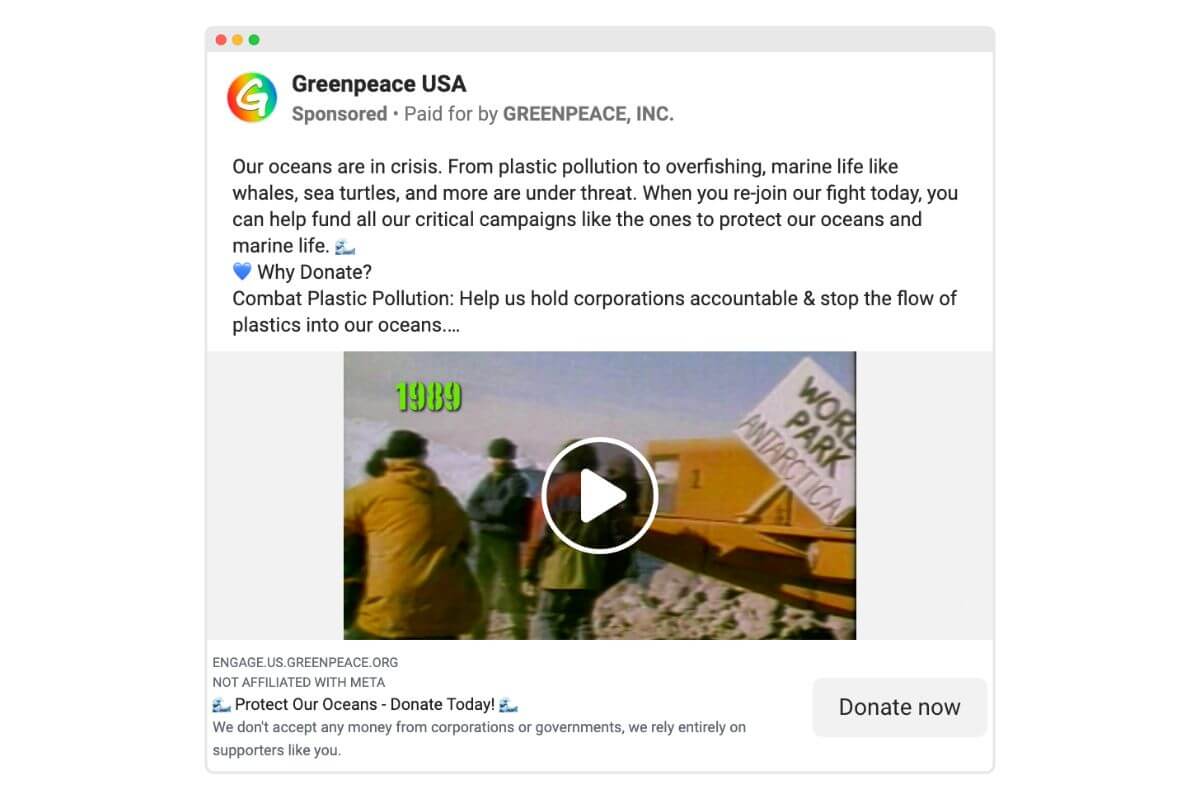
Don’t go en masse only, though. Creating donor-exclusive content makes your audience feel valued. In the end, you’ve done something special for them. Regular updates on your nonprofit’s progress through various channels help build a strong connection with donors.
Such consistent communication also keeps your cause at the forefront of their minds so they are more likely to support your initiatives continuously – since they see you. Your supporters will always appreciate the transparency and accountability that comes through regular communication.
Run a revenue projection strategy
Imagine planning a successful fundraising event without knowing when your donors usually give. Planning backward from expected donation dates can improve your fundraising strategy.
The ability to predict when donors are most likely to donate allows you to tailor your communication, promotional campaigns, or other engagement efforts. Fundraising activities that are aligned with donor behavior produce more effective and timely solicitations. With a well-planned revenue projection strategy, your fundraising efforts will always be timely and relevant.
Show donor impact
Many nonprofits struggle to show the tangible impact of donations. We have mentioned this a few times in this article already, but even a single message to donors can have a huge impact on their future involvement! Regular communication can solve this challenge. Donors want to know their contributions are making a real difference.
They want to feel good about it, and your job here is to make them feel good about it.
Not all donors want a broad overview. Regular updates and specific program reports on how donations are used provide the transparency many seek. Contrary to widespread belief, donors appreciate detailed information on how their contributions are allocated to the last cent. If you are able to, provide them with that information and make them feel taken care of.
Providing regular updates on the impact of their donations reassures them that their support is valuable, but also proves you’re trustworthy. Detailed reports, stories, and visuals showcasing the positive outcomes of their contributions motivate them to keep supporting your cause. Clear, impactful communication transforms occasional donors into loyal supporters.
The more you do here, the better.
Sharing specific updates about various programs improves both donor trust and satisfaction. When donors see exactly where their money goes, they feel more confident and are more likely to continue their support. Transparency also attracts new donors who value accountability.
Thank you calls and emails
Did you know that many first-time donors never give again if not promptly thanked? Thank-you messages and regular "I Know You" communication go a long, long way – and you should capitalize on that if you want to impact donor retention. Immediate acknowledgment of donations through calls or emails makes donors feel acknowledged for what they did towards your organization.
Here is one of the examples from JustGiving – it’s not just “thanks”, it’s “thanks again”, with a double personalization from a long fundraiser and the entire organization:
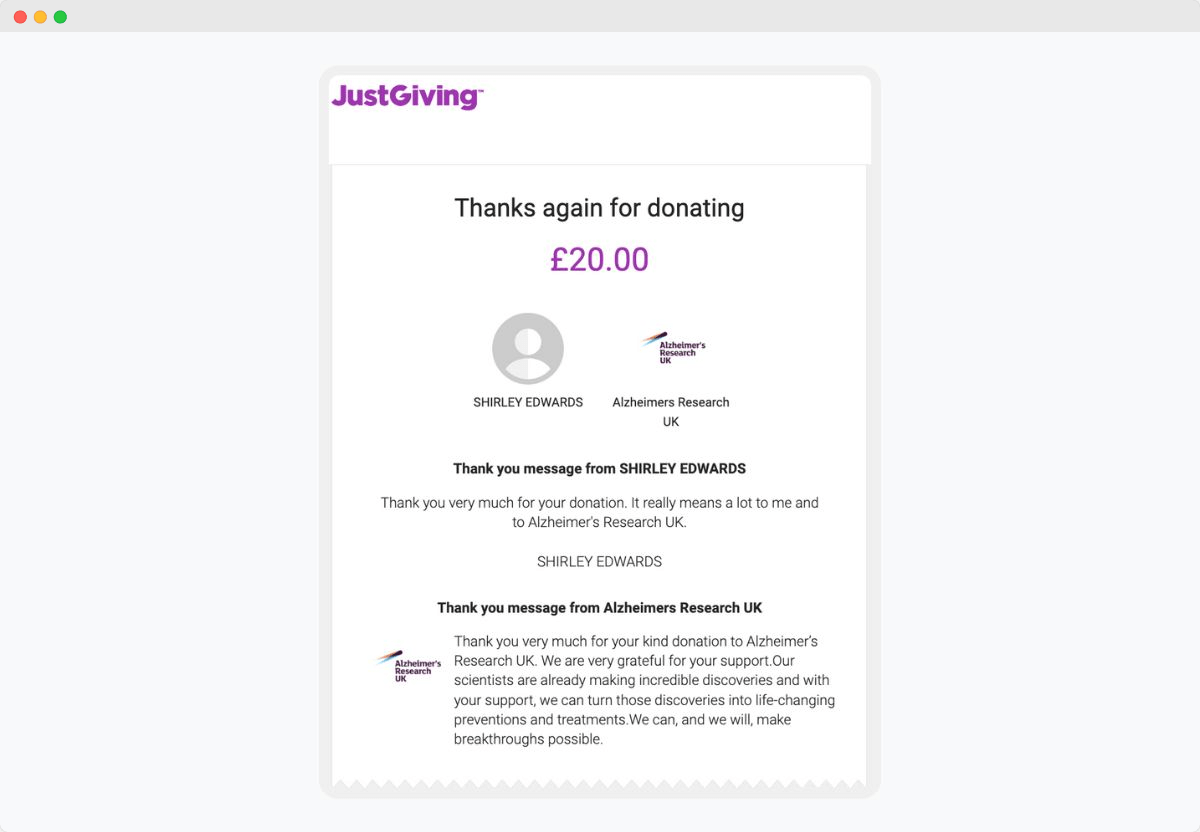
Speaking of personalization, you shouldn't just do it for a single message after a donation...
Personalized messages and customized giving options
Many believe that a one-size-fits-all message is enough. This is a myth. It is the easiest way of communication, but it’s NOT enough.
Personalized messages and customized giving options go hand in hand for effective donor engagement. Offer them customized giving options, such as specific projects or recurring donation plans, to make them feel more in control. Personalization changes generic approach into meaningful interactions – all of that to encourage higher levels of support.
Personalized communication, including details about their specific donation impact, reinforces their importance to your organization.
These practices show donors that their contributions are changing the world for the better. It might appeal to their egos, encourage repeat donations, and build long-term loyalty. And that’s what you should treat as a priority.
Survey donors and act on feedback
Taking action on donors' feedback naturally invites repeat donations. Knowing their preferences and concerns helps you adjust your approach to meet their expectations.
For example, you can discover that certain donors prefer more frequent updates about specific projects, while others might appreciate access to exclusive events instead of overwhelming emails.
Regular surveys provide valuable insights into donor satisfaction and areas for improvement. Gathering donor feedback shows donors that their opinions matter, but it’s responding and performing to it that shows that you really care.
Building trust through transparency
What builds lasting donor relationships? Transparency.
You need to take care of elements such as:
clear financial reporting
impact reports
donor privacy
open communication channels
governance practices
Donors need to see how their contributions are used and how impactful they are. Transparent reporting and open communication build credibility.
This example from Unicef illustrates how much help costs and what it delivers in detail ($21 for 40 food packs or $39 for empowerment packs). That's what we mean by transparency.
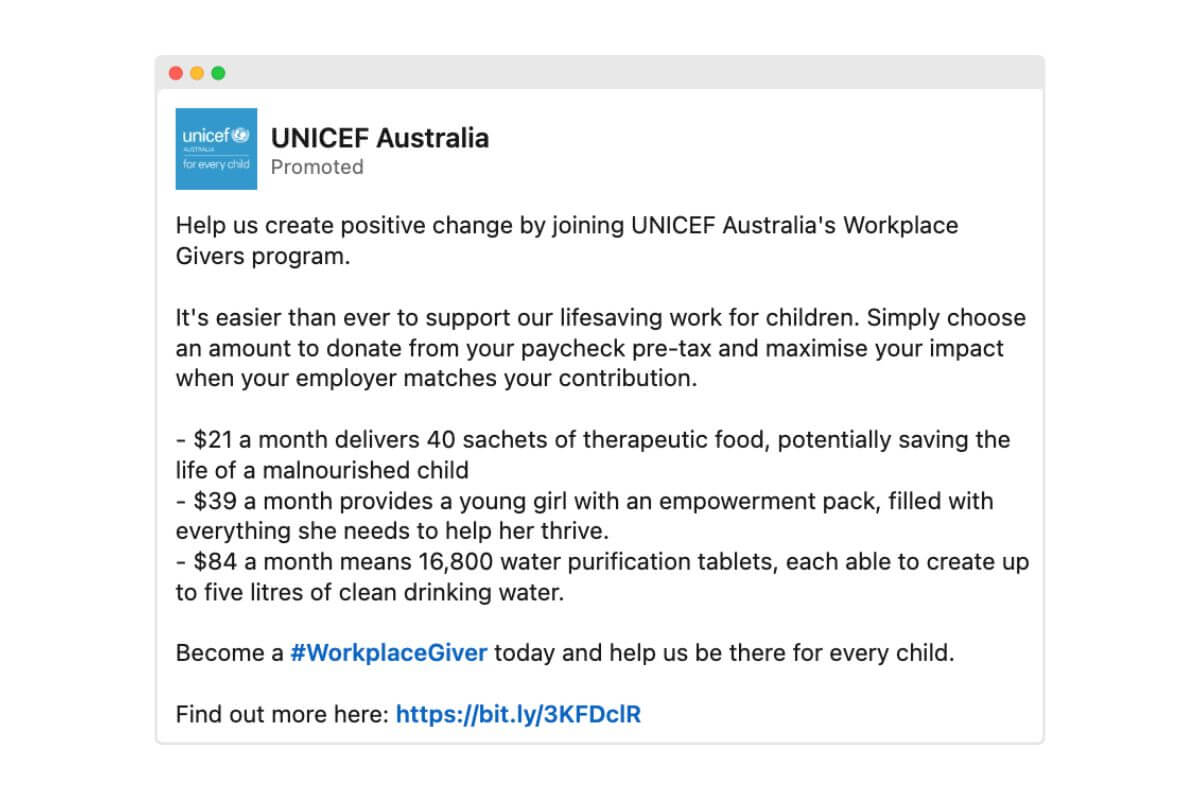
Charity: Water doesn't just collect money for causes, but presents them publicly with a description of a specific fundraising campaign along with a particular fundraiser.
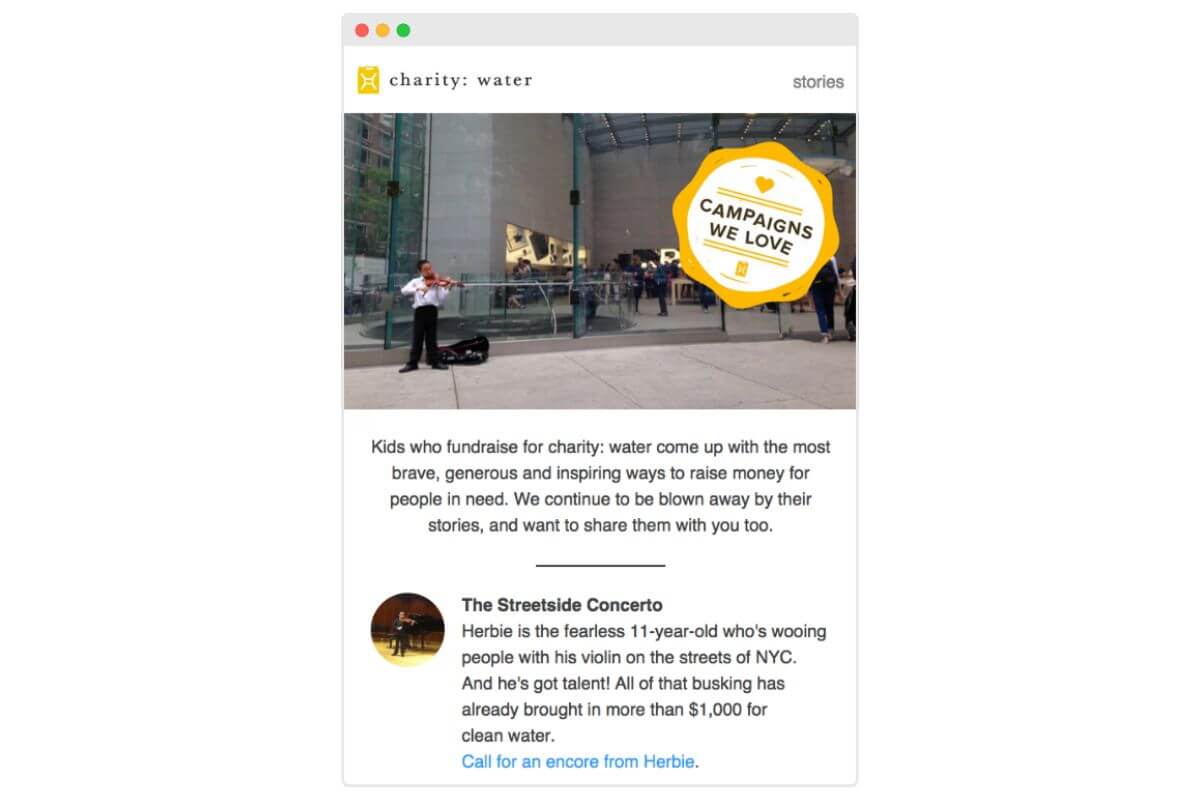
Protecting donor privacy (if requested) and demonstrating accountability through strong governance practices further solidify this trust.
Trust makes donors more likely to support your cause and advocate for it, as transparency also improves your nonprofit's reputation.
Use public recognition
Picture a donor scrolling through LinkedIn and seeing their name mentioned in appreciation...
Public recognition on social media, websites, or special donor walls increases donor satisfaction and loyalty. Publicly acknowledging donations, with consent, showcases your appreciation and highlights their contribution to your cause.
Recognition makes donors feel seen – but also inspires others to contribute. Creating a culture of recognition motivates donors to continue supporting your nonprofit. It works like a flywheel for a donor lifecycle. On top of building a positive image, public recognition encourages new donors to join the initiative.
Cultivation visits and event invites
Your offline relations are just as important as your online communications.
Direct interaction is irreplaceable in the donor journey. Cultivation visits, event invites, and volunteer opportunities provide face-to-face interactions that deepen donor relationships and can quickly bring in more donations – even those made in person.
Inviting donors to visit your programs or attend special events allows them to see firsthand the impact of their contributions and ask you questions they wouldn’t ask through e-mails or calls.
Engaging donors face-to-face can strengthen the bond between your organization and donors and guarantee sustained support.
Key metrics for donor relationship management
Well, now you know why donor relationship management matters and how to implement it. It’s worth knowing how to measure its impact as well. Why measure? To check which promotion channel is best, which donor segment is most profitable, and whether loyalty needs improvement. Without measurement, it’s all guesswork. Below, you will find four basic donor key metrics to track.
01 Donation frequency
Donation frequency tracks how often donors give to your nonprofit. It helps identify highly engaged donors who regularly support your cause.
How to measure it? Number of donations in a period / Number of donors.
How to analyze it? Compare frequency across different donor segments to identify trends. A good benchmark is at least two donations per year per donor.
How to improve it? Engage donors with regular updates and targeted campaigns to stimulate more frequent donations.
02 Average gift size
Average gift size measures the typical amount donated by each donor. You can use it to assess your donors' overall financial contribution.
How to measure it? Total donation amount / Number of donations.
How to analyze it? Monitor changes over time to see if your campaigns are increasing donation amounts. An average gift size of $75 to $100 is considered strong.
How to improve it? Encourage larger donations by showcasing the impact of higher contributions and offering tiered giving levels.
03 Donor retention rate
Donor retention rate measures the percentage of donors who continue to give year after year. High retention rates indicate strong donor loyalty and satisfaction.
How to measure it? (Number of repeat donors this year / Number of donors last year) x 100.
How to analyze it? Compare retention rates across different donor segments and campaigns. A retention rate of 60% or higher is considered good.
How to improve it? Keep building strong relationships through various donor appreciation methods.
04 Number of new donors acquired
This metric tracks the number of first-time donors to your nonprofit. It indicates the effectiveness of your outreach and acquisition efforts.
How to measure it? Count the number of new donors within a specific period.
How to analyze it? Identify which campaigns or channels are most effective in acquiring new donors. Aiming for a 10-15% increase in new donors annually is a good target.
How to improve it? Increase efforts in marketing, social media outreach, and referral programs to attract new donors.
Types of donors – and how to recognize their contributions
Every donor is valuable, but not every donor is the same. Here's a breakdown of different donor types and how to best recognize their contributions.
New donors
New donors are individuals who have recently been acquired by your organization and already made their first contribution. If you want them to become regular donors, you need to make sure they feel appreciated immediately. Personalized emails acknowledging their support can create a strong initial connection. Then, if allowed, social media mentions can further help with recognition or visibility. It doesn’t – and shouldn’t – stop here, though. Issuing personalized certificates of appreciation words to donors, with the donor’s name and the cause they supported, can improve this connection from the get-go and give it that unique element that many other fundraisers might just be missing. It's easy to make these certificates with Certifier's customizable templates and add a personal touch.
A single thank you certificate can do more than solid job in building relationships with new donors.
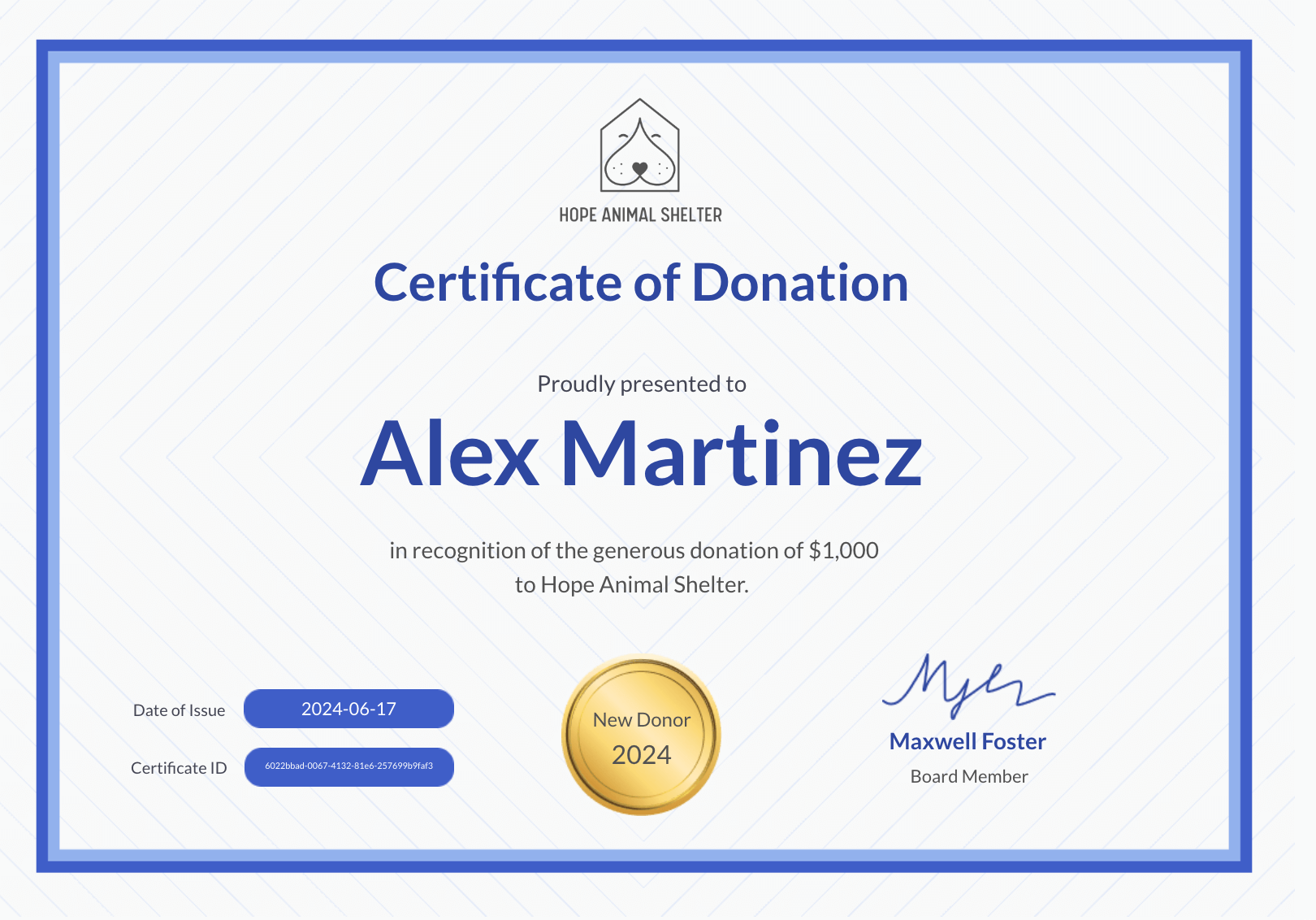
Recurring donors
Recurring donors regularly contribute to your organization – they are committed and value ongoing involvement. It is common for fundraisers to take this group for granted, believing that if they already contributed to a cause or two, they will continue to do so.
However, since getting a new donor is often more expensive than retaining the existing one, you should make sure that you know how to appreciate them.
You can use exclusive events or personalized phone calls, but they take time – especially if you have many donors already. Fortunately, there is a way to consistently, almost on autopilot, recognize them for every donation they make.
To acknowledge their ongoing support, use Certifier’s dynamic attributes feature to create personalized certificates for appreciation for each donation. In just a few clicks, you can customize the certificate for any donor occasion and send it from one place.
Consistent recognition encourages loyalty and long-term commitment, so you shouldn’t miss that in your strategy!
Major donors
Major donors make substantial financial contributions, so they might also expect a higher level of acknowledgment.
Public recognition through events or social media posts (including the $$$) highlights their impact but might not be enough for their liking. Personalized donors gifts show gratitude and thoughtfulness, and special events tailored to their interests make them feel valued.
Presenting certificates of appreciation that detail especially the donation amount and specific impact further cements their importance to your organization.
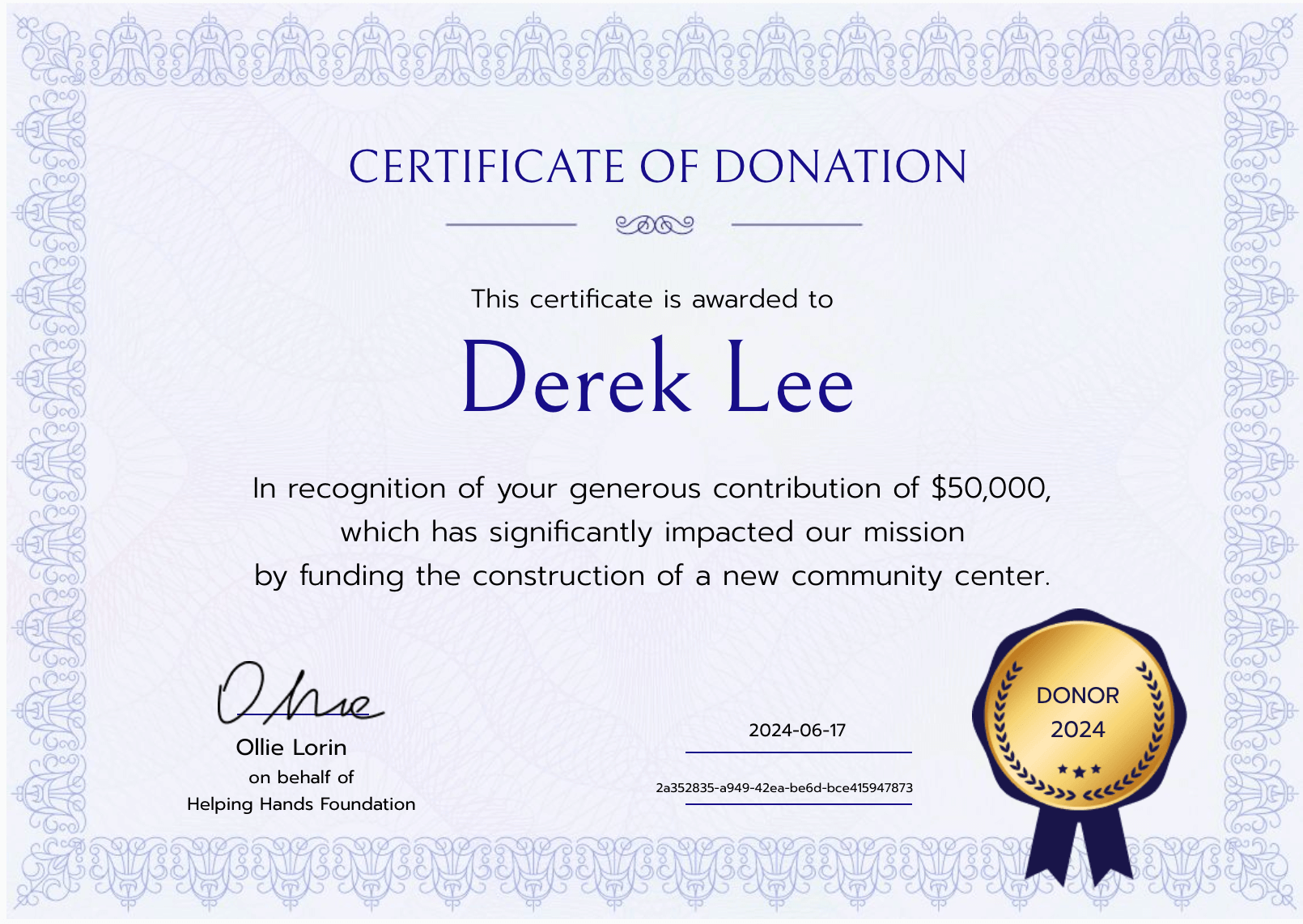
🖨️ A Certifier certificate comes in a print-ready PDF format, so if a donor wants to print and frame the certificate, you don’t have to worry about quality issues. They get it, smile, print it, and hang it for others to see. Simple as that.
Legacy donors
Legacy donors plan to leave substantial contributions through wills or trusts. They seek lasting recognition (even post mortem) and a legacy that reflects their values. Naming opportunities, such as dedicating buildings or programs in their honor, provide long-term acknowledgment.
Other donors
Other donors may include one-time contributors, or event attendees who decided to chip in during that particular event. Personalized notes expressing gratitude make them feel appreciated.
When it comes to events, we're talking about a large number of contributions made in a short time, so you have to find a smart way to recognize them (Certifier can help here a lot).
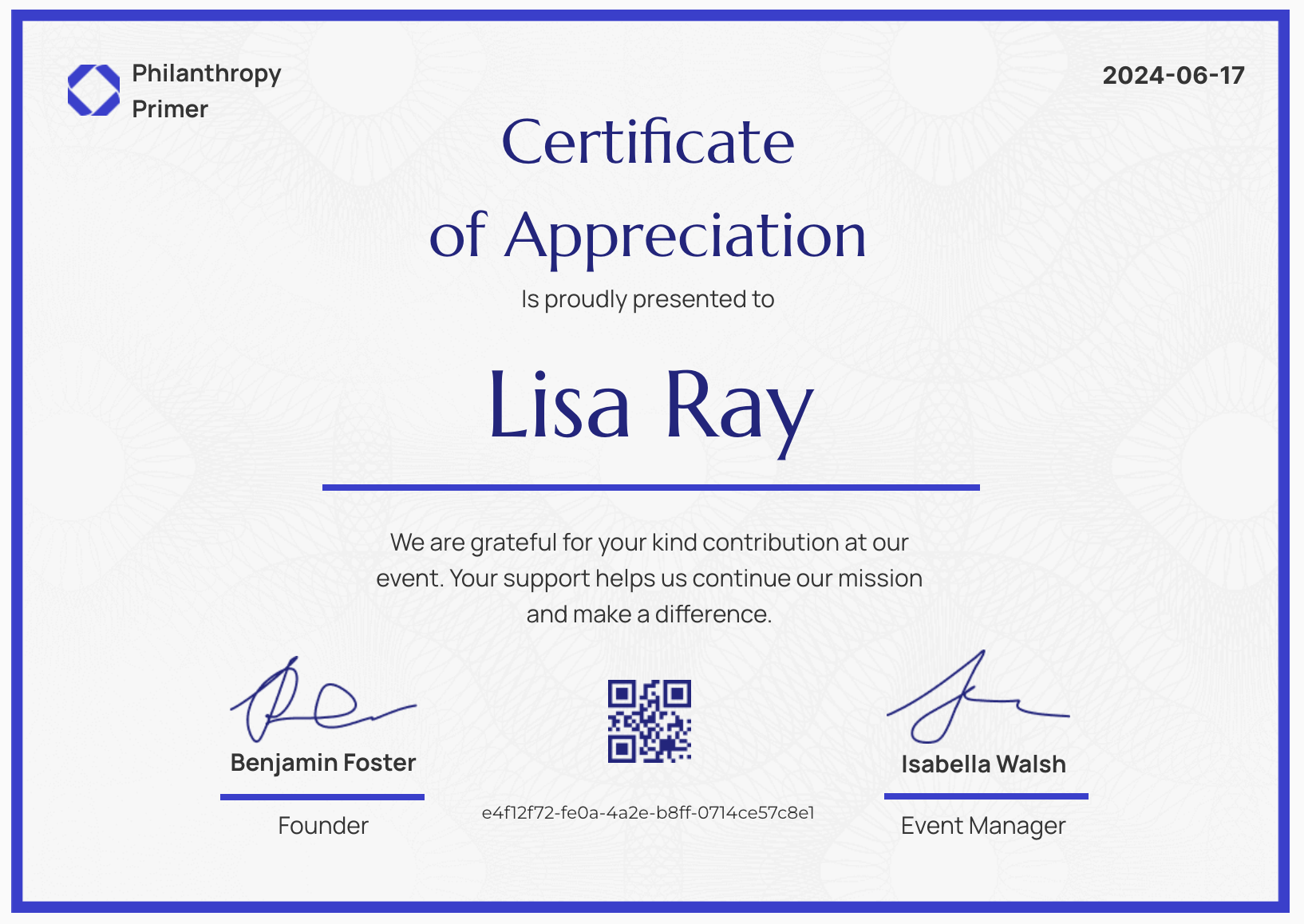
Inactive donors
Inactive donors have stopped contributing for various reasons. Some of them might have been natural (e.g., no financial ability), and you can’t do much about it. However, there might be some donors who decided not to donate because… of you.
Re-engaging any of them requires understanding why they stopped donating.
First, open conversations through phone calls or surveys can provide initial insights. Based on these, you can categorize the donors into those who are recoverable and those who are not.
New fundraising techniques not used before or by any other group, such as raffles or prize-led events, can reignite their interest. You should also reiterate the impact of past contributions in communications can remind them of the difference they made.
It is likely that they resigned from donating because they were uncertain if any of their donations were worthwhile. Bring them back to your fundraiser by showing them they made a difference.
Build stronger donor relations
Donor relations are not just about taking, but about giving. However, while monetary reasons may be the main driving force, it's the connections that drive that forward.
Effective donor relationship management sustains and grows your nonprofit. Understanding your donors' motivations is one thing, but putting them into practice is another. Make every donor feel appreciated with a small "thank you" gesture, such as a personalized certificate. With Certifier, you can create certificates quickly, personalize them on the spot, and get them to your donors in seconds.
Certifier offers a 15% lifelong discount for all nonprofits, making it easier to build and maintain strong donor connections. Contact sales for more information and verification!
FAQ about donor relationship management
More questions on building donor relations? Let us answer them below.

- B2B SaaS marketing
- Digital Credentials
- Content Strategy
- On-page SEO
- Lead Generation
Head of Marketing
Aksen leads marketing at Certifier, bringing 7+ years of experience with global brands to position digital credentialing as a trusted solution for training providers and educational institutions.


